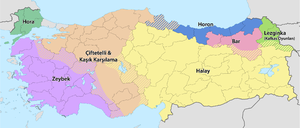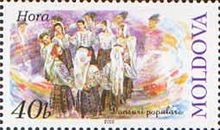- Hora (dance)
-
 A traditional oro playing in Republic of Macedonia
A traditional oro playing in Republic of Macedonia
Hora is a type of circle dance originating in the Balkans but also found in other countries. The name (spelled differently in different countries) is cognate to the Greek χορός : 'dance' which is cognate with the ancient Greek art form of χορεία; see Chorea. The original meaning of the Greek word χορός may have been 'circle'. Also the word is present in Slavic languages and "hora" and "oro" are found in many Slavic languages and have the meaning of round (dance) and the verb 'oriti' means to speak, sound, sing which previously meant to celebrate.
The Greek χορός is cognate with Bulgarian хоро 'horo', Serbian коло 'kolo', Croatian/Bosnian/Montenegrin 'kolo', Macedonian/Montenegrin 'oro', the Turkish form 'hora', 'valle' in Albania and Romanian 'horǎ'.
Contents
Hora in Romania and Moldova
Hora (pl. hore) is a traditional Romanian folk dance that gathers everyone into a big closed circle. The dancers hold each other's hands and the circle spins, usually counterclockwise, as each participant follows a sequence of three steps forward and one step back. The dance is usually accompanied by musical instruments such as the cymbalum, accordion, violin, viola, double bass, saxophone, trumpet or even the panflute.
The Hora is popular during wedding celebrations and festivals, and is an essential part of the social entertainment in rural areas. One of the most famous hore is the Hora Unirii (Hora of the Union), which became a Romanian patriotic song as a result of being the hymn when Wallachia and Moldavia united to form the Principality of Romania in 1859. During the 2006/2007 New Year's Eve celebration, when Romania and Bulgaria joined the European Union, people were dancing Hora Bucuriei (Hora of Joy) over the boulevards of Bucharest as a tribute to the EU anthem, Ode to Joy (Odă bucuriei). Some of the biggest hora circles can be found on early 20th century movies filmed by the Manakis brothers in Pindus, Greece and performed by local Aromanians.
Variants:
Hora in Bulgaria
The traditional Bulgarian dance horo (Bulgarian: 'хоро') comes in many shapes. It is not necessary to be in a circle, a curving line of people is also acceptable. The steps used in a horo dance are extremely diverse and not just two or three steps forward and one step back. The horo may vary between three to seven or eight steps forward and one to five or six steps back depending on the specific type.
There are more than five types of horo that are usually danced at every wedding. They differ by the rhythm of the music and the steps taken. There are no two horo dances with similar steps. There are probably over one hundred types of horo dances in the Bulgarian folklore.
In the past, the horo dance had a social role in Bulgarian society. It was mainly for fun, as a contest of skills, or for the show, leading to the development of the variety of horo dances. There are hora for people with little skill that can be learned in five to ten minutes, but there are also very sophisticated dances that cannot be learned unless one is fluent in many of the simpler dances.
Oro in Macedonia
The Republic of Macedonia uses the Cyrillic spelling of "oro" (Cyrillic: Opo). The origins of Macedonian oro vary from its use in socializing and celebrating, to historical dancing before going into battle. "TESHKOTO", translated "The difficult one", is one of those, danced by men only, and the music of which reflects the sorrow and mood of war. Oro in Macedonia reflects past hardships that Macedonians endured through melody, lyrics and movements. Today, oro is danced in a circle, with men and women holding one another by hand. They are used to celebrate present happy occasions, such as weddings, christenings, name-days, national and religious holidays, graduations, birthdays.
Oro in Montenegro
A similar dance, the Oro (Cyrillic: Opo), is popular in Montenegro. It starts with participants dancing in circles to a gusle, and ends with dancers standing on other dancers' shoulders and a toast from the head of the household. People consider it to be an "eagle-dance" (in Montenegrin vernaculars usual pronunciation for Montenegrin orao "eagle" is oro), since the two dancers within the circle jump while flapping their arms upward and shouting. Oro is considered the dance of the brave ones and danced mostly by men.
Gypsy oro
The Oro is also popular among the Roma people of Eastern Europe, and the dancing is practically the same as the one of the neighbouring ethnicities. Gypsy oros, and Romani music in general, are very well appreciated among non-gypsies in the Balkans .
The Hora in Klezmer music
The Hora in klezmer music is the same as the traditional Romanian dance. It has a slow, limping gait in 3/8 time and often leads into a faster and more upbeat freylekh or bulgar.[1]
Jewish Hora
Jewish and
Israeli musicReligious Contemporary
Piyyut · Zemirot · Nigun
Pizmonim · BaqashotSecular Dance Israeli folk dancing · Ballet
Horah · Hava Nagila
Yemenite dancingIsrael Hatikvah · Jerusalem of Gold Piyyutim Adon Olam · Geshem · Lekhah Dodi
Ma'oz Tzur · Yedid Nefesh · YigdalMusic for Holidays Shabbat
The hora (הורה), which is somewhat different from that of some of the Eastern European countries, is widespread in the Jewish diaspora and played a foundational role in modern Israeli folk dancing. It was brought to Israel by the Romanian settlers in the second half of the 19th century and became the symbol of the reconstruction of the country by the socialistic-agricultural Zionist movement.
It is usually performed to Israeli folk songs, and sometimes to Jewish songs, typically to the music of Hava Nagila.
To start the dance, everybody forms a circle, holding hands, and steps forward toward the right with the left foot, then follows with the right foot. The left foot is then brought back, followed by the right foot. This is done while holding hands and circling together in a fast and cheerful motion to the right. Large groups allow for the creation of several concentric circles.
In the early days, Hora was popular mainly in the Kibbutzim and small communities. Later it became a must in group dances throughout Israel, and at weddings and other celebrations by Jews in Israel, the United States and Canada. The dance appeared in North America in the early 20th century, well before modern Israeli independence, brought directly from Eastern Europe by Jewish immigrants.
At bar and bat mitzvahs, it is customary to raise the honoree and his or her family members on a chair during the hora. This is also done nowadays at many Jewish weddings, following the Israeli tradition.
The song Hora, sung by Avi Toledano, who represented Israel in the Eurovision Song Contest 1982, is based on this dance.
See also
- Circle dance
- Greek dances
- Round dance
- Bulgarian dances, details for specific Bulgarian folk dances
- Dabke, a Middle Eastern line dance
- Halay, a Middle Eastern dance
- Hasapiko, a Greek folk dance
- Khorovod, an Eastern European circle dance
- Kolo, Croatian and Bosnian circle dance
- Adana, a Macedonian oro
- Tresenica, a Macedonian oro performed by women
- Valle e Rugoves
External links
- The history of sacred dances: Choros, Hora, Calusul and Morris dance
- How to dance the Hora
- Hora Music, how do you dance the Hora in Israel - Lyrics to Hava Nagila
- A history of Jewish Hora (in Romanian, written by Romanian Jews)
- Description and history of Romanian Hora (in French)
Music of Southeastern Europe (the Balkans) By style Pop-folkArabesque ·Chalga · Laïko · Manele · Turbo-folk
Folk musicOtherBy country  Albania ·
Albania ·
 Bosnia and Herzegovina ·
Bosnia and Herzegovina ·  Bulgaria ·
Bulgaria ·  Croatia ·
Croatia ·  Greece ·
Greece ·  Republic of Macedonia ·
Republic of Macedonia ·  Moldova ·
Moldova ·  Montenegro ·
Montenegro ·  Romania ·
Romania ·  Serbia ·
Serbia ·  Slovenia ·
Slovenia ·  Turkey
TurkeyPerformers by country Albania ·Bosnia and Herzegovina · Bulgaria · Croatia · Greece · Republic of Macedonia · Moldova · Montenegro · Romania · Serbia · Slovenia · Turkey
Folk dances Circle dancesOtherBy countryFolk musicians Albanian folk musicians ·Categories:- Circle dances
- Greek words and phrases
- European folk dances
- Romanian folk dances
- Turkish dances
- Greek culture
- Jewish music
- Montenegrin culture
- Macedonian culture
- Romanian culture
- Turkish culture
- Klezmer
Wikimedia Foundation. 2010.



